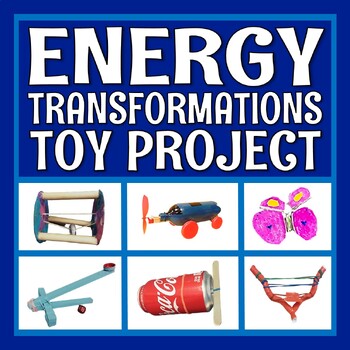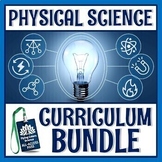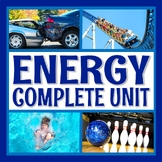Potential Kinetic Energy Project Forms of Energy Transformations Activity
Flying Colors Science
4.8k Followers
Grade Levels
6th - 8th
Subjects
Resource Type
Standards
NGSSMS-PS3-2
NGSSMS-PS3-5
NGSSHS-PS3-3
Formats Included
- PDF
- Easel Activity
Pages
4 pages
Flying Colors Science
4.8k Followers
Easel Activity Included
This resource includes a ready-to-use interactive activity students can complete on any device. Easel by TPT is free to use! Learn more.
What educators are saying
Used this for my gifted/honors students and they presented their toys to staff at my school. It was the talk of the school! Great project and resource to use!!
This was a FABULOUS way for my students to extend their understanding of energy tranformations! Thank you for creating a great resource!
Also included in
- SAVE 30% OFF list prices plus a FREE BONUS! Includes 6 NO or LOW PREP activities! Includes engaging activities, graphing practice, hands-on stations, a low-prep lab, and a fun project for energy transformations - all designed to SUPPLEMENT and add FUN to an existing energy unit! ⭐ Looking for a FPrice $15.50Original Price $22.47Save $6.97
- Never search for "something to do tomorrow" ever again! This bundle contains PRINT AND GO lessons, NO PREP activities, LOW PREP labs, and ENGAGING articles to supplement and thoroughly enhance a physical science course. Every included resource is easy to implement, standards-based, and high-quality.Price $399.99Original Price $671.34Save $271.35
- SAVE 50% on 3 weeks of lesson plans! This bundle includes every resource we use to teach forms of energy, energy transformations, the law of conservation of energy, and how different factors affect energy. All of the work has been done for you - from start to finish!This set of resources forms a CPrice $25.00Original Price $50.71Save $25.71
Description
Challenge students to create a simple TOY based on ENERGY TRANSFORMATIONS. Students use free or cheap supplies for their projects, but the results are incredible!
⭐ Get this resource at a HUGE discount in our Energy Unit! ⭐
How It Works:
- Students get a letter from a toy company asking them to design a toy that demonstrates an energy transformation. The letter gives them clear and specific parameters and includes a student-friendly rubric.
- The students present their toys to the "board of directors" (your class!). As the class watch the presentations, they record the energy transformation in each toy.
- Grade the toys based on the easy-to-use rubric.
Why You'll LOVE this Project:
- It is easy to DIFFERENTIATE. Students can make a toy as simple as a drum to as complicated as their imagination can take them!
- NO COST! No special supplies are required. Students can use old toy parts or recycled/upcycled materials like plastic containers or boxes.
- Kids say it is the FUNNEST PROJECT they’ve done all year!
What's Included:
- Clear directions describing the challenge and specific parameters
- Easy-to-follow, student-friendly rubric
- Graphic organizer for students to complete as their peers present projects
- Teacher hints and tips
- Pictures of past projects for reference
Easy and Cheap Materials:
Students can use whatever they can get their hands on to make their toys. For an idea of how simple the materials can be, just look at some past projects made from upcycled supplies:
- musical instrument (toilet paper roll, elastics)
- propeller boat (water bottle, elastics, plastic spoons)
- ping pong launcher (balloon, plastic cup)
Keeping the focus on upcycled materials helps keep ALL students involved, regardless of their ability to buy supplies at a store.
Teacher Notes:
- Please note: This resource is NOT editable.
- NGSS Standards: MS-PS3-2 and MS-PS3-5
- NGSS Science & Engineering Practice: Developing and using models
Total Pages
4 pages
Answer Key
Rubric only
Teaching Duration
N/A
Report this resource to TPT
Reported resources will be reviewed by our team. Report this resource to let us know if this resource violates TPT’s content guidelines.
Standards
to see state-specific standards (only available in the US).
NGSSMS-PS3-2
Develop a model to describe that when the arrangement of objects interacting at a distance changes, different amounts of potential energy are stored in the system. Emphasis is on relative amounts of potential energy, not on calculations of potential energy. Examples of objects within systems interacting at varying distances could include: the Earth and either a roller coaster cart at varying positions on a hill or objects at varying heights on shelves, changing the direction/orientation of a magnet, and a balloon with static electrical charge being brought closer to a classmate’s hair. Examples of models could include representations, diagrams, pictures, and written descriptions of systems. Assessment is limited to two objects and electric, magnetic, and gravitational interactions.
NGSSMS-PS3-5
Construct, use, and present arguments to support the claim that when the kinetic energy of an object changes, energy is transferred to or from the object. Examples of empirical evidence used in arguments could include an inventory or other representation of the energy before and after the transfer in the form of temperature changes or motion of object. Assessment does not include calculations of energy.
NGSSHS-PS3-3
Design, build, and refine a device that works within given constraints to convert one form of energy into another form of energy. Emphasis is on both qualitative and quantitative evaluations of devices. Examples of devices could include Rube Goldberg devices, wind turbines, solar cells, solar ovens, and generators. Examples of constraints could include use of renewable energy forms and efficiency. Assessment for quantitative evaluations is limited to total output for a given input. Assessment is limited to devices constructed with materials provided to students.








